338 BC -- The beginning: Conquest of the Latin
League.
279 BC -- minimum: Losses to Pyrrhus.
212 BC --minimum: Hannibal's Campaigns.
86 BC -- minimum: Losses to Mithridates.
9 AD -- Maximum: Augustus' Conquest of Germany.
116 -- Maximum: Trajan's Victory over the
Parthians.
269 -- minimum: Secession of the Gallic Empire and
Palmyra.
336 -- Maximum: Reunification under Constantine.
485 -- minimum: Loss of the West to Germanic
Kingdoms.
565 -- Maximum: Justinian's reconquest of the West.
623 -- minimum: Losses to Avars and Persia.
754 -- minimum: Losses to Arabs and Lombards.
812 -- Maximum: The "Renovation of Rimperial Rome"
by Charlemagne.
925 -- minimum: End of Western Empire, Losses to
Bulgars and Arabs.
1040 -- Maximum: Revival of the West, Revanche
of the East.
1181 -- Maximum: Expansion into Poland.
1288 -- Maximum: Reunification of the East.
1403 -- Maximum: Respite from the Turks.
1452 -- The End: Conquest by the Turks.
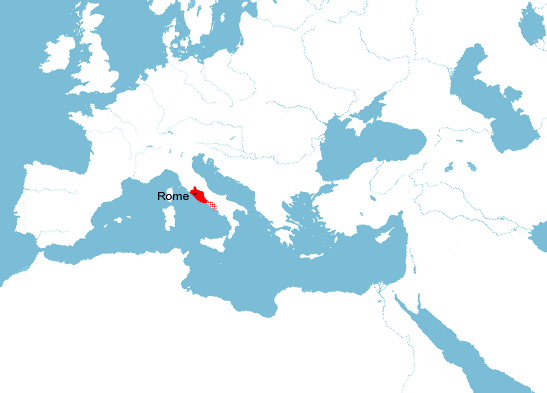
In legend, Rome was founded in 753 BC by Romulus, supposedly the
descendant of Aeneas, a survivor from the destruction of Troy. The city
only emerges clearly out of legend and into history around 510 BC, when
it overthrew its Etruscan rulers (to the north-west)
and became a republic. It rapidly grew in size and power, becoming the
leading city in central Italy and supreme commander of the League of
Latin Cities in times of war. In 340 BC the Latin cities revolted, but Rome
defeated
them and they came under direct Roman rule in 338 BC. This area, the
nascent Roman Empire, is indicated in red
in
the above map. The stippled red area is
Capua,
an independent area owing allegiance to the Roman Empire. These
conventions apply to all of the maps below also.
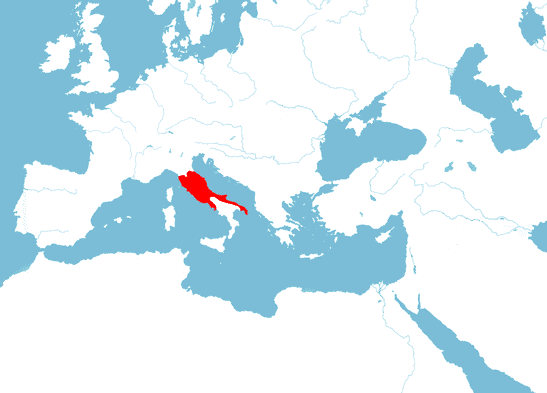
In 326-290 BC Rome won the struggle for control of Italy against its
main rival, the Samnites to the south-east. The Samnite allies included
the Etruscans, and the Gauls to the north-west. Almost the whole of
central and southern Italy came under Roman rule. Under threat, the Greek
cities on the "sole" of Italy called in Pyrrhus, Greek king of Epirus (across
the Adriatic from the "heel" of Italy). He beat the Roman legions and
drove them out of most of southern Italy in 279 BC. However the losses
to his own forces were enormous, whence the phrase a "Pyrrhic victory".
Pyrrhus went on to conquer Sicily from the Carthaginians, who were
allied to Rome in this war.
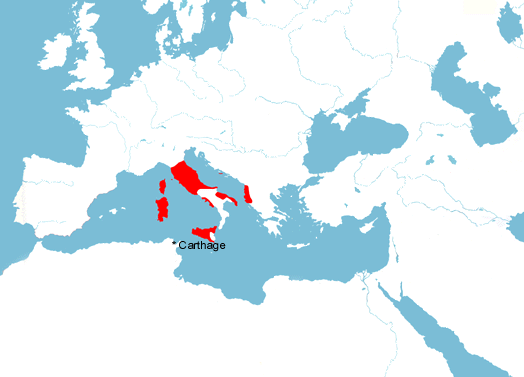
The Romans finally got the better of Pyrrhus in 275 BC, and by 272
BC had secured the entirety of southern Italy. The next target of Rome's
aggression was the great maritime Empire of Carthage. The first Punic war (so
called because Carthage was originally a Punic, i.e. Phoenician, colony) of
264-241 BC ended in a Carthaginian defeat. The western Mediterranean islands of
Sicily, Sardinia and Corsica were ceded to Rome. Rome acquired
territories across the Adriatic in anti-piracy campaigns in the the 220s, and at
the same time conquered the Celts in northern Italy. Meanwhile, Carthage
had rebuilt its position by conquering much of Spain, and it was here that
the second Punic war began in 218. This time it was a war for
survival. The great Carthaginian general Hannibal defeated the Romans in Spain
and invaded Italy over the Alps. There he inflicted defeat after defeat on
the Roman legions, the worst being at Cannae in 216 where the Romans
lost some 50 000 legionaries. As during the invasion of Pyrrhus, the Samnites
defected, and so did the Greek South, followed by Syracuse in Sicily in 214.
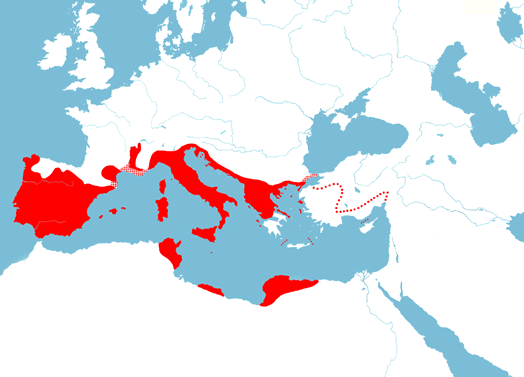
Despite his victories, Hannibal was not prepared to move on Rome itself,
and the Roman legions finally secured a victory against him in 211.
Elsewhere, Roman forces were also gaining the upper hand. In 203 Hannibal
evacuated Italy, to defend Carthage against a Roman attack. There he was defeated
by the Roman general Scipio in 202, and the war was concluded with
harsh terms imposed upon Carthage. Rome acquired the whole eastern coast of
Spain, and went on to conquer most of the country by 133 BC. As usual, Rome
was at war most of the time, and everywhere its legions were eventually
successful. Macedonia was annexed in 148 BC, Greece and Carthage two years later.
By
this time, the city of Rome had reached the 100 000 mark and its
only rivals were Antioch, capital of the rapidly shrinking Selucid Kingdom, and
Alexandria, capital of the Ptolemaic Kingdom of Egypt. Such was Rome's prestige
that the king of Pergamum in western Anatolia bowed to the inevitable and in
133 BC bequeathed his kingdom to Rome. By 100 BC Rome's territory in
the East stretched as far as the dotted border in the above map. Only
one kingdom dared challenge Roman supremacy:
Pontus, on the southern shore of the Black Sea. From 110-100 BC, King
Mithridates (120-66 BC) more than quadrupled its territory, expanding eastward,
southward (temporarily conquering the Roman protectorates in central Anatolia),
and northward (conquering the Bosporan Kingdom on the northern shore of the Black
Sea). In 88 BC, as Italy was just emerging from the "Social War" (which
compelled Rome to extend the citizenship to all of Italy), Mithridates struck
westward. The Roman province of Asia was over-run and 60 000 Romans executed. In
86 BC southern Greece defected to Mithridates, and received a Pontic
army. Rome's strategic position in the East seemed to be falling apart.
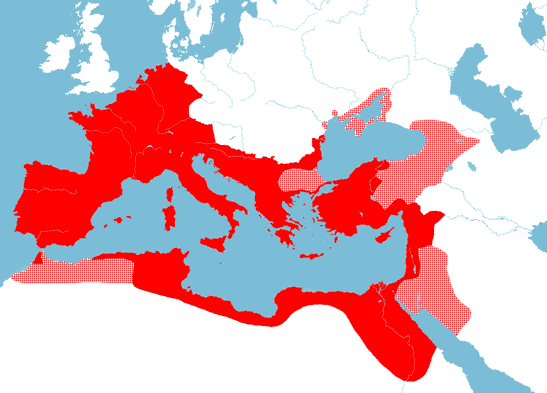
Rome's efforts to put Mithridates back in his place were hampered by
civil strife at home between the populists led by Marius and the
aristocrats led by Sulla. However, the latter defeated Mithridates in 85 BC, and
the eastern frontier was restored by 81 BC. But Mithridates had not given
up, and Sulla's successor Pompey was sent East again. By 66 BC, the Roman
victory was complete: Mithridates committed suicide, the coast from Pontus to
Syria (inclusive) was annexed to Rome, and the interior reduced to vassalage.
In the west, Pompey's rival Julius Caesar (nephew of Marius) made even
more spectacular gains during his military appointment, conquering all
of Gaul by 51 BC and even raiding Britain. By this time the republican
system was clearly breaking down as rival generals sought absolute
power, or a share in it. The civil wars of 49-30 BC ended with this absolute
power in the hands of Octavian, great-nephew and adopted son of Caesar. In 27 BC the
Senate bestowed upon him the honorary title Augustus. As the first Emperor of
Rome he was careful nevertheless to maintain the institutions of the
Republic, and the fiction of their role in government. Legally, he was merely the
Princeps,
the first citizen, and so this system is called the Principate.
Octavian tidied up the borders of the Empire left to him by his predecessors
by annexing or reducing to vassalage all of the land south of the
Danube and Rhine, West of the Euphrates, and North of the Sahara. His most
ambitious project was to conquer Germany, which seemed well in hand by 9 AD.
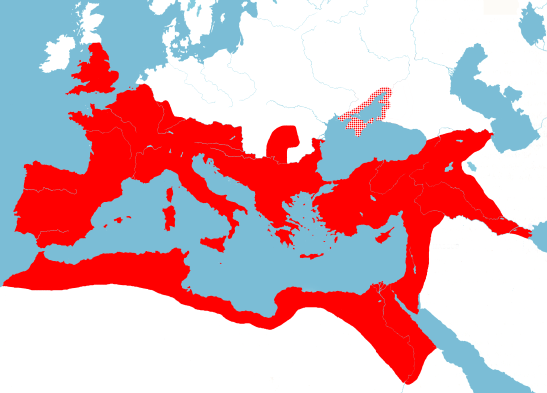
Germany proved more trouble than it was worth when three legions
(about 15 000 men) were ambushed and annihilated in the Tutoburger forest in 9
A.D. The frontier was pulled back to the Rhine, but elsewhere modest
expansion continued under Octavian's relatives, the Julio-Claudian dynasty.
Most notably, Britain was conquered (43-80). In 68, the deeply unpopular Nero,
last of the Julio-Claudians, committed suicide.
Out of the ensuing civil war the commander of the eastern
armies, Flavian, emerged victorious. The end of his short-lived dynasty
in 96 was followed by almost a century of stable and capable rule by
the adoptive
Emperors, so called because each adopted his most promising subordinate
as his successor. This was the time Gibbon called "the period in the history
of the world during which the condition of the human race was most happy
and prosperous". The population of Rome reflected this, reaching perhaps
500 000, the largest in the world. For the most part the adoptive Emperors
were content to maintain the territorial limits of the Empire, but the
notable exception is Trajan (98-117). He conquered the troublesome Dacians
on the north shore of the Danube (101-106), and in 114 went to war with
the Parthian Empire, Rome's rival to the east. He annexed Armenia in 114,
northern Mesopotamia in 115, and occupied southern Mesopotamia all the
way to the Persian gulf in 116.
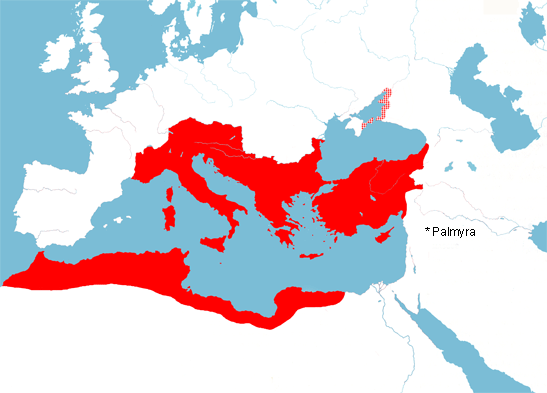
Trajan's conquests in the east would have been difficult to hold, and his
successor Hadrian (117-138) immediately pulled the frontier back to the
Euphrates, although Armenia remained a client state. The following Pax Romana
lasted until the murder of Commodus, the last adopted Emperor. The
ensuing civil war (193-97) was won by Severus, whose dynasty maintained stability
until 235. But for an Empire made rich on conquest and plunder,
peace did not necessarily mean prosperity. The coinage was repeatedly debased
from about 170 onwards, and by the time of this map the silver content
was only a few percent. In 212 all free men in the Empire were made citizens,
an attempt to increase its tax base. With economic decline came political
instability: in the half century after 235, there were 15 Emperors,
most ruling only a few years. At the same time, Rome's enemies had become
more powerful. In the east, the Parthians had been replaced in 226 by the
Sassanid Persians, who sought to restore the glory of the Persian Empire 700
years before. They sacked Antioch in 253 and took the Emperor Valerian
prisoner at Edessa in 260. Simultaneously, Germans raided deep into the Empire,
reaching the Mediterranean at several points. The Empire's impotence
prompted regional commanders to seize control in the worst affected areas. In
the west, Postumus founded a Gallic Empire in 260, including Spain and
Britain. In the east, the semi-independent trading city of Palmyra became the
centre for resistance. Its ruler, Odenathus beat back the Persians and even
sacked their capital Ctephiston. On his death in 267, his more ambitious
widow, Zenobia, took power, and had by 269 ruled Roman Syria, Palestine
and Egypt.
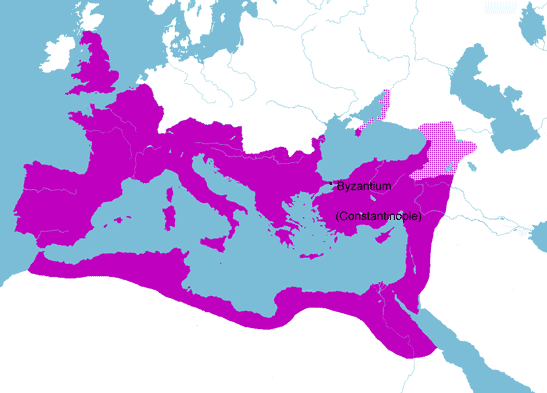
Under Emperor Aurelian (270-75), Zenobia was defeated and captured in 273, and the Gallic Empire fully retaken by 275. Against the odds, the Empire had survived the ``Crisis of the Third Century'', losing only peripheral territories, and even gaining against the Sassanids. Stable government was restored under Diocletian (284-305), although inflation continued unchecked. Recognizing the need for regional-based commanders, he divided the Empire in two (East and West) each under an Augustus. The legal pretences of the Principate were dropped; citizens became subject of the Emperor, who was their lord (dominus, whence the form of government is termed the Dominate). Diocletian also instituted a regular means for succession, the Tetrarchy, involving two more junior Emperors, the Caesars. This worked once only, on Diocletian's retirement. After that, predictably, the plethora of Emperors and their disinherited sons led to civil war. The eventual victor and sole Emperor from 324 to 337 was Constantine the great. He is notable for two incalculably important decisions. First, he converted to Christianity, and under his dynasty (which lasted until 363) it became the dominant religion of the Empire. Second, he founded New Rome, a Christian capital, on the site of Byzantium, in 330. A second Senate was created for Constantinople (as it soon became known), and each Senate now nominated one Consul each year. As it had been during the Republic (in which the two Consuls shared the executive power), their names were used to identify the year. In the East, Constantinople also held the Imperial court, whereas in the West, it was in Milan, and from 405 in Ravenna. This new situation, of an Empire with two capitals (Rome and Byzantium) is indicated by the change from red to purple in the above map. In addition, Constantine created a new gold coinage, which was to remain unchanged for centuries, and even reconquered some land north of the Danube.

In 375, the Visigoths, fleeing the Huns who had invaded Europe from central Asia, were allowed to settle south of the Danube. Poorly treated, they revolted in 378 and destroyed the Imperial army sent against them. With Roman subjects increasingly unwilling to serve in the army, the Empire took to replacing them with German tribes en masse, starting with the Visigoths themselves In 395, Theodosius the great, the last Emperor of the East and West, died, dividing the Empire between his two sons. Taking advantage of the situation, the Visigoths revolted again in 395. They eventually invaded Italy and sacked Rome in 410. Meanwhile, Vandals and Sueves had invaded across the Rhine, and Britain had rebelled. The Empire in the West had recovered somewhat by 420, but was economically crippled when the Vandals took Africa in the 430s. Under their last great general Aetius, the West had just enough strength to repel the Huns from Gaul in 451, with help from its German allies. After that it went into terminal decline, and by 476 had almost no territory outside Italy. In that year the last Western Emperor, by chance named Romulus, was deposed by his military commander Odovacer. Like his predecessors in the job for two decades, Odovacer was of German origin, and now titled himself King of Italy. Odovacer claimed to govern in the name of Emperor Zeno in the East. The East had always been the richer half, and had survived the Germanic and Hunnic invasions mostly unscathed. At first Zeno did not accept Odovacer's offer, but in 480 he granted him the title of Patrician, and from 483 he allowed the Senate in Rome to nominate one of the two Consuls, as it had done under the Emperors. This curious state of affairs around 485 is indicated by the colours of the above map. Odovacer's kingdom is coloured pale red: although it was in fact the successor to the Western Roman Empire, it did not claim to be such. But it is also stippled purple because it was nominally part of a united Empire.

Zeno was never really reconciled to Odovacer's position in Italy,
and had no qualms in encouraging the Ostrogoths (who from 476 to 488
occupied the stippled area south of the Danube in the 485 map) to Invade Italy
in 488. By 493, their king Theodoric had replaced Odovacer, and again
claimed to rule in the name of the Emperor (now Anastasius I). Theodoric
strengthened and expanded his kingdom,
and ruled as a Roman Emperor in all but name.
Anastasius even returned the Imperial regalia (surrendered by Odovacer
in 476) to Italy in 497. Theodoric died in 526 and the next year
Justinian the great came to the throne in Constantinople, with a mission to
regain the West for the Empire. From 533 to 540 his general Belisarius
conquered Africa from the Vandals and most of Italy from the Ostrogoths.
But Belisarius was recalled, the Ostrogoths
rallied, and the ruinous war in Italy dragged on. When Ostrogothic
resistance finally ceased in 563, the city of Rome was a shadow of its former
self. Justinian
had already abolished the Senate there, and the office of Consul
altogether.
Although it held Rome, Justinian's Empire
was ruled entirely from Constantinople (Byzantium). It is
conventional, and so convenient, to call this the Byzantine Empire, indicated by
blue
colouring. However his name was not
used in the Empire itself, which never forsook the Roman name. Constantinople
was now as large as Rome in its
heyday, with a population of some 500 000, and again the largest city
in the world. Simultaneously with the final Italian campaign, Justinian
sent Imperial troops to help the pro-Roman Athanagild gain the throne of the
Visigothic kingdom in Spain. Athanaglid was successful, and in return
acknowledged Imperial suzerainty, and ceded southern Spain to the Empire.
Justinian's achievements in field of conquest were remarkable, but
become truly amazing when one realizes that he left an equally
great legacy in
the fields of the law (his Digest
laid the foundations of European law) and architecture (the Hagia Sophia
was the largest cathedral in the world for nearly a thousand years),
and all this at a time when the Empire suffered the "Justinianic" plague,
one of the worst in all history.
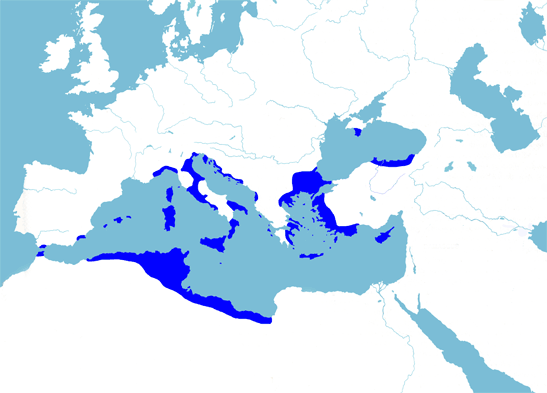
Justinian was barely cold in his grave (565) when his rebuilt Empire
began to crumble. Fleeing the Avars (who played much the same role that
the Huns had done almost 200 years earlier), the Lombards invaded Italy
in 568. When a temporary equilibrium was reached by about 605, the
Romans had managed to keep almost half the country, and to prevent the
formation of a unified Lombard kingdom. In 565 the Visigoths repudiated Roman
suzerainty, and began the process of reducing the Imperial province in Spain, which
was all but complete by 623. The Balkans were repeatedly raided by
Avars, and Slav settlers immigrated in their wake. Finally, taking advantage
of a palace coup in Constantinople, the Sassanid King Chosroes II of
Persia invaded in 603, and had conquered Mesopotamia by 610. This prompted
another coup in Constantinople, which saw Heraclius, the son of the governor of
Africa, installed on the throne. But the Persians continued to advance,
and by 621 had conquered Syria, Palestine, Egypt, Armenia and most of
Anatolia. Most of the Balkans were occupied by the Avars. The Empire
appeared so weak that the Sassanids now set their sights on nothing
less than a complete conquest. Heraclius, meanwhile, had been
rebuilding the army, and had appropriated
all the wealth of Constantinople (including that of the Church). Having
paid off the Avars, in 622 he set out for the East via the Black sea.
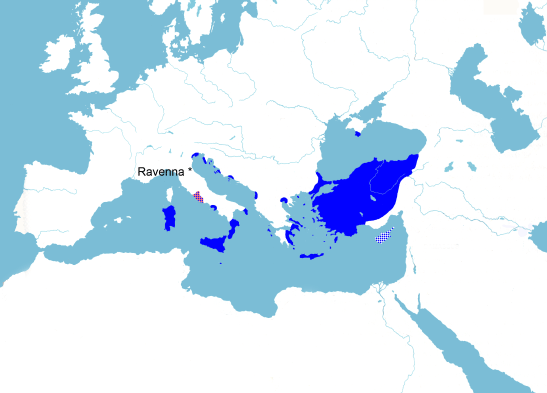
In a series of brilliant campaigns from 622 to 628, Heraclius ravaged the heartlands of Persia. Putting his faith (justly) in the walls of Constantinople, the Imperial navy, and the Holy Virgin, he ignored a siege of his capital by the Persians and perfidious Avars in 626. With bravery bordering on recklessness he led his army to victory after victory. In 628 the Sassanid aristocracy overthrew Chosroes and opened negotiations for peace. By 630 the Imperial frontier in the East had been fully restored. It seems a pity that Heraclius did not die immediately following his Triumph in 631, rather than live, as he did, for another 10 years, and see the Arabs conquer most of the lands he had just recovered. United by the new faith of Mohammed, they burst forth from Arabia in 634 and overwhelmed the exhausted armies of the Roman and Persian Empires. Nevertheless, Heraclius is remembered as one of the great soldier-Emperors, the founder of a dynasty that lasted 100 years, the last Emperor to come to the throne from the Latin West, but the first to adopt the Greek title Basileus (rather than Imperator). His provincial home of Carthage, the last Roman territory in Africa, fell to the Arabs in 698. Every year the Arabs raided deep into Anatolia, and they besieged Constantinople in 674-8 and again in 717-8. The population of Constantinople sunk to less than 50 000 and without even a functioning aqueduct (Luttwak 2009, p.217). Meanwhile in Italy the Lombards were, little by little, acquiring the Empire's territory. In 751 they finally captured the Imperial headquarters, Ravenna. Rome was clearly next, with no hope of reinforcements from Constantinople. Pope Zachary (who had been de facto ruler of Rome since 741) took the extraordinary step of seeking help instead from the Frankish kingdom. In 751 he approved Pepin's elevation from Major-Domo (a position which had been the real power behind the throne for a century) to King of the Franks. Pepin returned the favour in 754 by forcing the Lombards out of the territory around Rome, which however nominally remained part of the Empire. Because of its ambiguous status it is coloured pale red with blue stippling, similarly to Odovacer's Kingdom in 485.
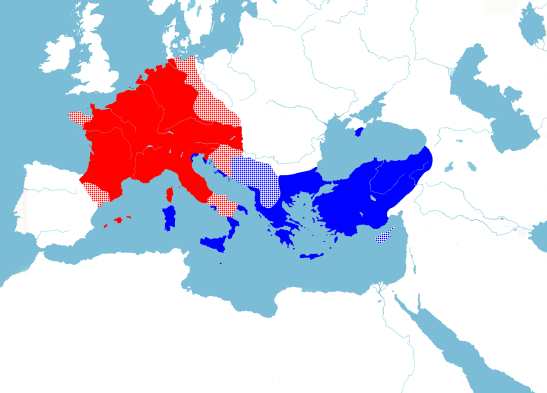
Zachary's successor Stephen cemented the Papal-Frankish alliance by conferring the title Patrician of the Romans upon Pepin in 754. In so doing he was usurping the role of the Emperor, but the latter was in no position to stop him. In 756 Pepin defeated the Lombard King again, and forced him to give up the last century of conquests from the Empire in northern Italy. The Emperor Constantine V demanded that the ceded territory be returned to the Empire, but instead Pepin gave it to the Pope, creating the Papal States (Patrimonium Petri). In 772 Papal bulls ceased to bear the Emperor's name. In 774 Pepin's son and successor Charles the great (Charlemagne) conquered the Lombard Kingdom, calling himself King of the Franks and Lombards. The Papal States became a Frankish protectorate, and Charles went on to conquer almost the whole of continental Christian Western Europe. In 800, when Charles was visiting Rome, Pope Leo III took the logical step of anointing him "Emperor governing the Roman Empire". This was reputedly to Charlie's own surprise, but he was happy to add "Renovatio Romani Imperii" to his seal. At first, the Byzantines ignored this claim, but, under military pressure from Charlemagne in the Adriatic and southern Italy, they recognized him as Emperor of the Franks in 812. They reserved the title Emperor of the Romans for themselves, and emphasized this point by introducing that inscription on their coins. Nevertheless, Charlemagne was clearly now the equal of the Byzantine Emperor, ruling over a reborn Roman Empire in the West. Meanwhile, in the East, the Byzantines had stabilized their frontier with the Arabs and regained significant territory in the Balkans from the Slavs.
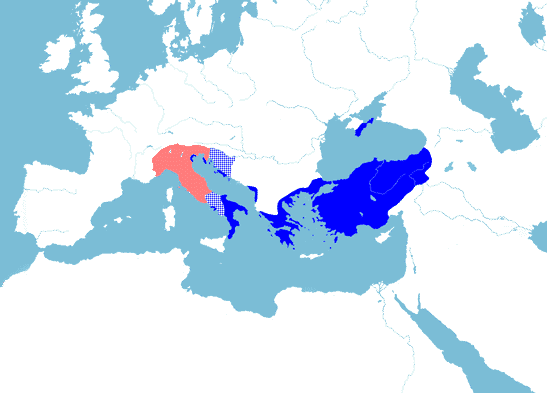
After Charlemagne's death in 814 the Western Empire began a slow
process of disintegration. By 888 it was reduced to northern and central
Italy, and after 924 its rulers ceased to pretend to be Emperors, and
instead called themselves Kings of Italy. As the most direct successor to the
Western Empire, this Kingdom is indicated above in pale
red.
Meanwhile, from 812 much of the Balkans had come under the rule of the
Bulgars, relatives of the Huns. They reached their peak under the Khan
Symeon (893-927), who was crowned Emperor of the Bulgars by the
Patriarch of Constantinople in 913. Despite failing to capture Constantinople in
926, he then ludicrously added "and the Romans" to his title.
Simultaneously, the Byzantine Empire suffered under a renewed Arab offensive, this time a
maritime one. Crete was lost in 823, Cyprus in 826, Sicily from 827-902, and
Sardinia as a consequence of the loss of Sicily. But on the Italian mainland,
Byzantine power was greater than it had been for two centuries, as they alone
were able to effectively oppose the Moslem pirates.
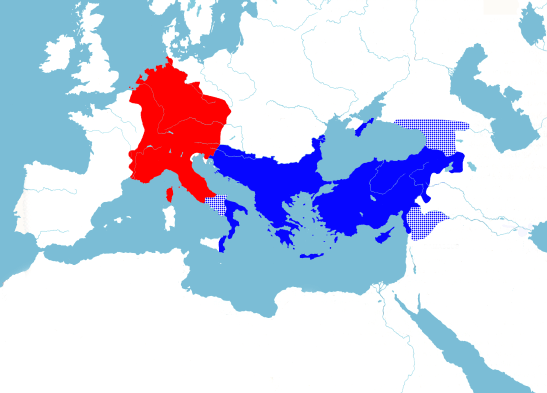
The eighty years from 960 to 1040 saw a remarkable recovery in the
fortunes
of the Roman Empires, much
of it already by 975. In the West most of the lands of
Charlemagne's Empire
were reunited, and this time the Empire proved far longer lasting. In
952 Otto I, King of Germany, had taken the Kingdom of Italy by force. In
962, the Pope crowned him Emperor in Rome, reviving the Western
Empire. The connection between Italy and Germany was made secure
by the addition of the Kingdom of Burgundy (south-east Gaul) in 1033.
Meanwhile the Eastern Empire regained territory it had lost up to four centuries
before. From 960 to 976, Nicephorus II Phocas, and John I Tzimisces,
first as generals and then as Emperors, conquered Crete, Cyprus, Cilicia,
much of Syria and Armenia. The Christian kingdoms in southern Italy and the
Caucuses, and the Moslem Emirate of Allepo, became Byzantine protectorates. The
Bulgarian Empire was defeated in 971 and its eastern half annexed to Byzantium. In 976,
John Tzimisces died, and the Bulgars badly mauled the army of Basil II
(976-1025) on his first campaign. By 986 their Empire was almost as
large as it had been under Symeon 60 years before. Basil bided his time, and
prepared his revenge. In almost continuous campaigning from 1000 to
1018, he utterly destroyed the Bulgar state, and annexed it, well earning his
epithet "the Bulgar-slayer". Serbia was also annexed and Croatia
submitted again. Venice, however, was now fully independent. Basil's successors,
the last of the Macedonian dynasty (867-1056), were weak rulers, but
the Empire continued to expand despite them. Edessa, on the far side of the
Euphrates, was taken in 1032 and in 1038 the reconquest of Sicily was
begun.

In Sicily, the Byzantine's Norman mercenaries revolted in 1040,
dissatisfied with their pay. They decamped to mainland Italy, where
their revolt spread. Sicily was abandoned in 1043. A succession of weak
rulers ran down the army
even while raids and revolts spread across the Empire. The gold coinage
was debased (for the first time since Constantine the great) by 25%. In
1053, 50 000 active troops on the eastern border were disbanded, while
inactive units
closer to Constantinople (and hence more of a threat politically) were
maintained. In 1071, the last Byzantine city in Italy fell to the
Norman adventurers, but a far greater
catastrophe was occurring on the eastern frontier. The reforming
Emperor Romanus Diogenes (1068-1071) led a huge, but largely mercenary, army
into Armenia, where it was
routed by the Seljuk Turks at Manzikert. Over the next two
decades, Turks occupied the whole of
Anatolia; the Empire could not field an
army to stop them. In desperation, Alexius I Comnenus (1081-1118) asked the
Pope in 1095 to help raise an army from Western Christendom. The result
was far beyond his expectation: in 1097 the army of the First Crusade
crossed from Constantinople to Anatolia. By 1098 it had fought its way to Syria
and Edessa. The Byzantine army accompanying it occupied as much of
Anatolia as it could, and the new Crusader states on Roman territory (as it had
been a generation before) promised to recognize the Emperor as their
overlord. Alexius' son John II (1118-1143) made further gains in Anatolia. John's
son Manuel I (1143-1180) forced the Crusaders to keep their word (as the
above map reflects) in 1158, and re-established the Empire's position of
dominance in the Balkans in 1159. The Western Roman Empire gained Sardinia in
1046, but lost the Duchy of Spoleto (east of Rome) in 1144. It also expanded
eastwards into Poland, making Silesia a dependency in 1163 and annexing
Pomerania in 1181.

After the death of Manuel Comnenus, the Eastern Empire went into
another rapid decline. From 1181 to 1187, Croatia was lost to the Hungarians,
and Serbia and Bulgaria regained independence. The Crusaders ceased to
recognize the Emperor's suzerainty and in 1190 captured Cyprus. Relations with
the West deteriorated, and civil wars broke out. In 1203, Alexius IV
Angelus, a pretender to the throne, promised 200 000 marks to the army of the
fourth Crusade if they would help him gain Constantinople and the throne. They
did so in 1204, but as Emperor he found the treasury empty. Losing
patience, the Crusaders sacked Constantinople in 1204 and placed one of their own
on the throne, bringing into being the Latin
Empire in Constantinople. The Crusaders
and Venice (which supplied their transport) managed to seize the whole
coast from Constantinople to southern Greece, the Aegean islands, and
the north-east coast of Anatolia. The remaining Byzantine
territory split into states contending for the mantle of the fallen Empire: the
Empire of Nicaea in western Anatolia, the Empire of Trebizond in northern
Anatolia, and the Despotate of Epirus on the Adriatic. The first of these was
ultimately successful, as Emperor Michael VIII Palaeologus recaptured
Constantinople from the decrepit Latin Empire in 1261.
Much of Bulgaria and Serbia was
regained, but a few Crusader states lingered on in southern Greece. In
1282 the Emperor of Trebizond agreed to call himself Despot instead,
accepting the primacy of the Emperor in Constantinople. The two remaining
independent Byzantine rulers in Greece also submitted: the Despot of Epirus in 1284
and the Sebastocrator of Thessalay in 1288. Meanwhile, however, the
Western Empire
was losing its hold over Italy. As early as 1183 the Lombard cities in
northern Italy had established their autonomy. The Roman Empire in the
West effectively ceased to exist in 1282, when Emperor Rudolph of Hapsburg recognized
the 1278 declaration of independence by the Papal States. Strictly,
Rudolph was King of the Romans rather
than Emperor, as he had not been crowned by the Pope – the last Papal
coronation had been in 1220. Ruled by the Pope in Rome, the Papal
States are indicated in pale
red in the above map.
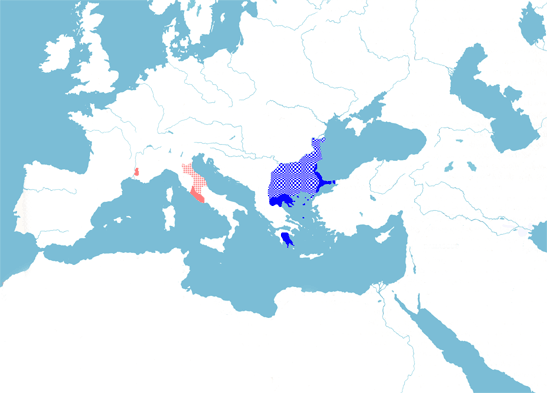
Despite all the disasters that had befallen the Roman Empire in the
East, its currency had always been the gold standard in Christendom.
But debasement of the gold content of the hyperperon to 7 parts in 12 by
1282 led the Venetians to mint their own pure gold coin, the ducat. It
rapidly replaced the hyperperon, a symptom of the fact that the Empire was
losing its trade profits to the Italian cities. With a shrinking treasury, the
Empire was unable to prevent the advance of the enemies that surrounded
it: Turks, Bulgarians, Serbs, Venetians and other Westerners. Civil war
again became endemic, and then the black death struck in 1347. By this
time the Empire had lost virtually all its Anatolian lands to various
Turkish emirates. One of these, the Ottomans, gained a foothold in Europe in
1354, as supporters of one faction in a civil war. By 1402 the Ottomans had
conquered almost all of Anatolia, and much of the Balkans. The Roman Empire was
reduced to Constantinople and the Morea (the southernmost part of Greece). The
future of the Empire seemed likely to be numbered in months, not years.
Then suddenly it had a respite: the last great nomad warrior, Timur the
lame, smashed the Ottoman army at Ankara. The Ottoman Sultanate fell
into warring factions under the late Sultan's sons, with Europe falling to
Suleyman. He restored
a few territories to the Roman Empire and even recognized Emperor
Manuel II Palaeologus as his suzerain (hence the large stippled area in
the above map). But Manuel still had to tread a diplomatic tightrope,
especially after Suleyman was captured and strangled by one of his
brothers in 1411. Meanwhile in the West, the Papal States relaxed their
grip on most of their Italian territories, during the exile of the Pope in
Avignon in France from 1309 to 1378.
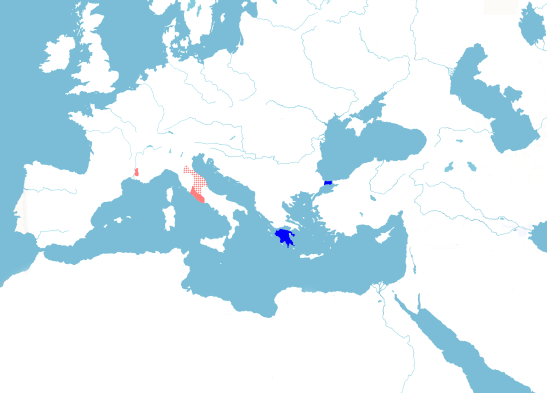
Although Timur died in 1404, the Ottoman Empire (under one Sultan again from 1413) took a generation to recover its territories in Europe, and much longer in Anatolia. Although an Ottoman siege of Constantinople in 1422 failed, they took Thessalonica (in northern Greece) in 1430. The Despotate of the Morea actually expanded, at the expense of the remaining petty Latin principalities, and the region saw a late flowering of Byzantine art and philosophy. In 1415 the Byzantines built the hexamilion, the six-mile wall, across the isthmus connecting Morea to the rest of Greece. In 1444 the Despot of Morea invaded Ottoman territory in conjunction with a last crusade from the West. In a close-fought battle at Varna the crusaders were defeated, and the Ottomans chased the Byzantines back over the hexamilion. In 1449 Constantine XI Palaeologus, came to the throne. The last Emperor hailed by the Senate in Rome was named after Rome's legendary founder, Romulus; the new Emperor in Constantinople was not only named after its founder, Constantine, but also had a mother of the same name, Helena. Many thought this augured the end of the Empire, and they were soon vindicated. A new Ottoman Sultan, Mehmet (named after the founder of his faith), came to the throne in 1451, and quickly made his plans apparent by building a huge fortress in 1452, next to Constantinople, on what was nominally Roman territory.
The final siege of Constantinople was short, lasting from the 5th of April to the 29th of May 1453. Using Hungarian-designed cannon of unprecedented size, the Sultan blasted away at the walls built by Theodosius the great more than a millennium before. Constantinople was defended by just 8 000 men, mostly Byzantines but with a sizeable contingent from Genoa. The Sultan's army numbered perhaps ten times as many. Defeat was inevitable. The injured Genoese captain Giovanni Longo escaped with his men by ship just in time. Constantine went down with his city. Donning his war gear, he plunged into the final fray, never to be seen again. Thus the Roman Empire finally ended after 1790 years.
The few remnant Byzantine states were mopped up by the Turks some years later: Morea in 1460 and Trebizond in 1461. But Byzantine culture continued in the southern Balkans and on the coasts of Anatolia, where many Greek-speakers still called themselves Romans (Rhomaioi) even into the 20th century. The Patriarch continues to reside in Constantinople, a figurehead for Orthodox Christians in eastern Europe, the Near East, and all over the world. Nor is the Byzantine legacy restricted to Orthodox cultures: the exodus of the Byzantine elite from southern Greece to Italy did much to boost the Renaissance of Classical learning there. Southern Greece regained independence from the Ottomans, in 1830. The modern frontiers of Greece were more or less attained in the early 1920s, when the Ottoman Empire came to an end. But Constantinople, now Istanbul, is still firmly in the hands of the Turkish state. Without it, modern Greece is inevitably seen as the heir to ancient Greece, rather than as the heir to the last Roman Empire.
Meanwhile, in the West, the Papacy was further weakened by the Great Schism (1378-1417) when there was a Pope both in Rome and in Avignon. However, by the mid 17th century it had regained direct control of the whole of the Patrimonium Petri as shown in the map for 1288. Recall that this territory was born as the Exarchate of Ravenna in the early 7th century, the largest surviving block of Roman territory in Italy following the Lombard invasions. Conquered by the Lombards in the mid 8th century, it was almost immediately restored and donated to the Pope by Pepin, King of the Franks. It continued to be ruled by the Papacy, as part of a larger state until 1282, and then independently, until 1861-70 when it was annexed by the new Kingdom of Italy. This Kingdom was the first unified Italian state since the Kingdom of the Ostrogoths, more than 1300 years before. For almost all of the intervening time, the band of territory linking Ravenna to Rome was a powerful factor against Italian unity, separating Lombardy and Tuscany in the north from what became the Kingdom of Naples in the south. The longevity and historical importance of this essentially artificial territory are almost as remarkable as those of the Roman Empire that gave birth to it.